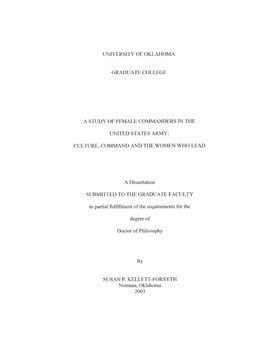| dc.contributor.advisor | Copeland, Gary W., | en_US |
| dc.contributor.author | Kellett-forsyth, Susan Puanani. | en_US |
| dc.date.accessioned | 2013-08-16T12:19:03Z | |
| dc.date.available | 2013-08-16T12:19:03Z | |
| dc.date.issued | 2003 | en_US |
| dc.identifier.uri | https://hdl.handle.net/11244/633 | |
| dc.description.abstract | Organizational changes occurred at the individual level through the development of personal relationships. Organizational changes were manifested in several ways. Organizational changes occurred through personal interaction and demonstrated ability. Organizational changes were seen as reactions to women in nontraditional jobs became more routine and less of a major, out of the ordinary event. The study's participants described how they felt the Army had changed during their time in the organization. Organizational changes were implied by the actions of the male leaders who made decisions that promoted the integration and advancement of women in the organization. Organizational changes were seen in the different approaches to the debate concerning women in the combat arms. | en_US |
| dc.description.abstract | This study has three major implications. The first implication concerns the overly simplistic nature of the Schein/Lewin change model and addresses its efficacy in accounting for individual and organizational changes. The second implication deals with organizational change and the realization that the military organization is unlikely to fundamentally change in the near or distant future. Finally, the third implication addresses what the future may hold for women in military organizations. | en_US |
| dc.description.abstract | This study's focus is on women who have chosen the Army as a career and who have continued to progress through its hierarchy, achieving command at battalion and brigade levels. The investigation centers on the strategies these women developed to cope, adapt, and better fit in a predominantly male organization during a process of integration. While the main focus is on the individual in a military environment, this study also considers the impact the individual may have had on the organization, and the changes that may have occurred as a result. Schein's elaboration of Lewin's change model is used as a way to explain and understand how the individual, both male and female, and the organization may have changed. | en_US |
| dc.description.abstract | Individual changes were considered in the analysis of the strategies used in the development of a workable persona. These strategies include being tough, being feminine, working harder, regendering and organizational fit. | en_US |
| dc.description.abstract | This study relied on a qualitative research strategy with semi-structured interviews as the primary method of inquiry. | en_US |
| dc.format.extent | xii, 163 leaves ; | en_US |
| dc.subject | Women's Studies. | en_US |
| dc.subject | Women soldiers United States. | en_US |
| dc.subject | Political Science, Public Administration. | en_US |
| dc.subject | United States. Army Officers. | en_US |
| dc.subject | United States Armed Forces Women. | en_US |
| dc.title | A study of female commanders in the United States Army: Culture, command and the women who lead. | en_US |
| dc.type | Thesis | en_US |
| dc.thesis.degree | Ph.D. | en_US |
| dc.thesis.degreeDiscipline | Department of Political Science | en_US |
| dc.note | Adviser: Gary W. Copeland. | en_US |
| dc.note | Source: Dissertation Abstracts International, Volume: 64-07, Section: A, page: 2672. | en_US |
| ou.identifier | (UMI)AAI3097224 | en_US |
| ou.group | College of Arts and Sciences::Department of Political Science | |
